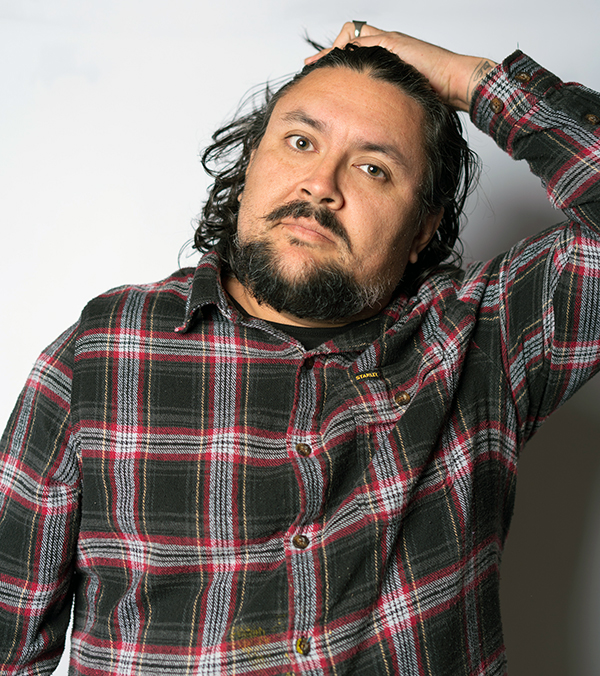Presented by Equity Bank

This has been quite a year for Chico Salvador Sierra. His painting Mama Gave Me Soul is on exhibit at the Nelson-Atkins through September. His work is also featured at Leawood Pioneer Library, and he paints from a studio at InterUrban ArtHouse (IUAH) in downtown Overland Park.
“It has been a busy year,” he says, “and I consider myself lucky to have been given so many opportunities and am also happy that the work I put into my art is appreciated. I am really proud of some of the murals I’ve completed, in particular the largest piece I’ve ever done at Union Station and a piece at GCI Middle School on the Westside through Spray KC. Another gratifying project was the showing of local Latino Artists titled Inspired by Maya, part of the Maya exhibit at Union Station last May.” Sierra helped curate that exhibit and would like to do more work of that kind.
Not bad for a guy from El Paso who skipped school to read in the library. Growing up in a multi-ethnic, multi-racial family in a border town with a fenced-off military base, Sierra has explored the notions of demarcations and lines, going beyond them to tap into pre-Columbian and pre-colonial images from the Indigenous heritage of his mother.
Wearing headphones to listen to music as he works, Sierra lets his colorful paintings—and his artistic career—evolve.
How has having your own studio space and your relationship with IUAH helped your career?
Having a studio at IUAH has been a contributing factor in the trajectory of my career. Having a dedicated space provides a sense of focus and importance to the work you’re doing. Having worked manual labor for the majority of my life, having a place to work puts me in a different headspace. I’ve considered installing an old-school time clock to add to the illusion. Other organizations throughout KC also played a part in my career, which I should mention for the benefit of other artists and those that would like to support art: Mid America Arts Alliance, Charlotte Street, KCAC, Jenny Mendez, and Dwight Smith, who are institutions in their own right.
Your work seems boundary-less, timeless, limitless, everything everywhere all at once. What in your experience has helped you cultivate this perspective?
There is a lot that culminates to create my perspective and how I approach visualizing my ideas. My beliefs are often counterintuitive and misaligned with what interests me. I am an atheist fascinated by beliefs of people whose spirituality is rooted in nature and the study of it. To me these belief systems are part of the beginnings of the scientific method. These groups often exist within nature and consider themselves a part of it, but I am not a person who is particularly comfortable in nature. I was born in a city in the desert. I view history and these beliefs people have as part of an important part of human evolutionary history, and I am always interested in how people came to hold beliefs. It blurs into how I think of how people interact with each other, nature, time, and space today.
Time blindness, a concept I haven’t truly grasped, is a symptom of ADHD, and I think that contributes to my view of all these things coupled with my brief history as a Christian missionary. My leftist views on social justice are all at the forefront of my mind as I paint. Growing up as a poor, Chicano, introverted sci-fi nerd in a multi-ethnic, multi-racial household and community—with parents who were always working in a border town with a military base—created a fragmented sense of limits and boundaries I’ve always seen as manmade. I also considered myself as an outsider looking in. Artwork is my way of starting a conversation about all these things.
Your colorful paintings combine many pre-Columbian, pre-colonial symbols and motifs from ancient peoples of what is now South America. What motifs are most meaningful to you? Why?
Growing up in a primarily Chicano community, there is a historical distance between our Indigenous cultural identity and what has become a separate culture. Chicanos are tied to Mexican history, but the lines are blurred by forced assimilation, and then there is the Indigenous root that is blurred even further by colonization. My own identity is clouded by several circumstances, but the knowledge of my mother’s indigenous racial identity was absolute. We did not have any information on a particular tribe, so I take artistic freedom to draw from a surface understanding of different cultures in the Western Hemisphere. I aim to tap into a particular feeling with people and force them to question what they think about what they’re seeing and what their connection is to a particular painting. I want to give people who, like me, have these roots in this land, whose histories are blurred and haven’t seen themselves in contemporary art, who can see that their history is part of all history and for non-spiritual people of color to see that their beliefs are rooted in humanity’s desire to understand the world.
Growing up in El Paso, what are the dishes that say “home” to you? Where do you and your family like to go to find them or do you prepare them at home?
El Paso has a particular cuisine that is not quite Tex-Mex, and not quite anything else. There is less cheese and more poblano, we use flour tortillas as opposed to corn. My mom makes the best flour tortillas, and that’s not opinion or hyperbole, that’s fact. She makes a burrito with ground beef and potatoes that is simple but definitely my favorite meal. In El Paso there is a place called Chico’s Tacos that is a cultural cornerstone. Yes, it did inspire the name that is now how I am known legally. I think places like that are historically significant and worthy of high praise and acknowledgement. I also think people should spend more time exploring the plethora of Central and South American restaurants in Kansas City, Kansas.


